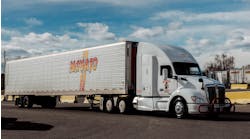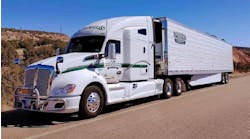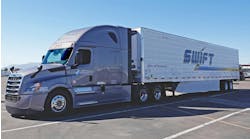Great Lakes Cold Logistics uses partnership to enhance services
Great Lakes Cold Logistics specializes in asset-based, full-service, temperature-controlled transportation services. Headquartered in Warrendale, Pennsylvania, a northern suburb of Pittsburgh, it was established in October 2004 to help Great Lakes Cold Storage better serve its customers. The transportation operation continues to grow. It now has 48-state operating authority, specializes in nationwide LTL services, operates a full-service brokerage operation, and does supply chain management. It was recently recognized for its nationwide less-than-truckload operation.
Great Lakes Cold Logistics is a sister company to Great Lakes Cold Storage, based in Solon, Ohio, a suburb of Cleveland. With a second facility in Cranberry Township in western Pennsylvania, Great Lakes Cold Storage has 8.6 million cubic feet of modern freezer/refrigerated space with -20° to +45° F capabilities.
Great Lakes Cold Storage was founded by Pat Gorbett in 1997 in his hometown of Cleveland, Ohio, when he purchased Gateway Cold Storage. Gorbett had been in the food business and saw the move as a good business opportunity.
In 1999 Gorbett bought a second cold storage, National Terminals in Solon, and changed the name of his company to Great Lakes Cold storage. The Cranberry Township facility was purchased in 2003.
Great Lakes Cold Logistics came about because of a confluence of several market conditions occurring in the early 2000's that greatly impacted the cold storage business, says Howard A Schillinger, who joined the company at its creation in 2004.
“The cold storage industry was changing from a cottage type industry of family-owned businesses to mega-size cold storage warehouse companies,” he explains, “making it tougher to compete by just offering cold air.”
The industry was also being driven by shorter lead times, just-in-time inventories, and smaller orders, making it more difficult to keep warehouses full. At the same time, more and more cold storage customers were asking for help in getting their products to market.
Consequently, Gorbett decided to re-create his business by adding supply chain management, says Schillinger.
Beginnings
Great Lakes Cold Storage consolidated its operations into the current two distribution centers, and Schillinger was brought on board to establish a logistics operation as a value-added service.
He has an extensive background in supply chain management from his many years at Food Brands America where he managed logistics operations. Before that he worked for the Carmar Group of public refrigerated warehouses where he also developed a nationwide LTL logistics service, begun as a brokerage operation.
Gorbett, along with his chief financial officer, Dan Palus, and Schillinger formed Great Lakes Cold Logistics in October 2004. Schillinger was named executive vice president.
“One of our goals for real value added transportation as a cold storage business was to have a true LTL operation,” says Schillinger. “That's a gutsy play because less-than-truckload is brutal. But we decided that was really where we wanted to be, and that would be our forte.”
Early on, Great Lakes Cold Logistics just did brokerage, working with existing customers to move truckloads, gain market experience, try new ideas, and get support from other businesses. In April 2005 it began building its own fleet of trucks. Since the beginning, the company has full-service leased its tractors.
“I have a long history in transportation and traffic, but I know little about tractors,” Schillinger admits. “What I do know is that I don't want to own any.
“We made the decision early on that we were going to focus all of our attention on our customers and service, and not be worried about managing tractor maintenance, etc. Our customers and their markets don't tolerate excuses anymore.”
Partnerships
Noting that “our entire operation is extremely partnership oriented,” Schillinger says the carrier has partnered up with closely screened companies for its truck and equipment needs.
Tractors, late model Freightliner sleepers with plenty of driver amenities, are on six-year full-service leases from Penske Truck Leasing. Trailers, however, are company owned.
Great Lakes Cold Storage's single-temperature trailers are about evenly split between Utility and Great Dane models. All are 53-foot, air-ride units, none older than three years.
All new refrigeration units are Carrier Transicold models, most recently the X2-2100-A units spec'd with the new optional Stealth noise reduction package. The aerodynamically-designed units come standard with improved access to mechanical parts for better serviceability; the UltraFresh 3 air- and temperature-management system that produces shorter, more efficient run cycles; the Extended Service Interval package; and the MessageCenter display that has a backlit display with step-by-step prompting and text messaging.
“Our transportation partners have been fantastic,” says Schillinger, “and we'll stay with them as long as they continue to take good care of us. Personally, I don't like to shop around unless I have to.”
Technology
He says he is a “big believer in improving and utilizing technology to gain efficiencies,” but doesn't have the time or inclination to keep up with such matters with regards to tractors and trailers.
“I depend upon my transportation partners to help me run my fleet as efficiently as I can. The trick of technology is not to just have it, but to use it effectively.
“For us,” continues Schillinger, “the partnership goes well beyond just our using your equipment. It means helping us watch operating variables and expenses.”
By way of example, he notes that his Carrier Transicold representative David Wilson of Carrier Transicold of Pennsylvania was responsible for the fleet adding technology to the trailers, including data loggers and StarTrak's ReeferTrak systems.
A wireless refrigeration operation management tool, ReeferTrak has GPS tracking and monitoring, along with direct full-authority communication, for transport refrigeration units, says Pat Donohue of StarTrak. The system allows wireless active control of almost any feature of any refrigeration unit in the fleet.
“With StarTrak, a fleet is able to gather useful and actionable information that management can use to better manage operations more effectively and efficiently,” he says.
All refrigerated trailers also have Carrier Transicold Advance microprocessor controllers with built-in data loggers. These are designed specifically to enhance a fleet's ability to monitor the condition of perishable products, Wilson says. Battery-powered, the devices allow for temperature monitoring from the point of origin to the final destination, providing a record of storage temperatures throughout the trip.
“David is sensitive to who our customers are and understands our value added initiative,” says Schillinger. “He does a lot of research and comes to us with good proposals. And that's the kind of help we want from our transportation partners.”
Internet
Great Lakes Cold Logistics is also taking advantage of Penske's Fleet IQ - a web-based fleet management system that captures critical performance data. Among other functions, the system can track and locate each vehicle; provide mpg, start/stops, and idle time; provide current, accurate driver logs; report state fuel tax automatically; identify potential engine problems; and enable communication with drivers through messaging.
The fleet is beginning to roll out wireless scanning technology for real-time pick-up and delivery data to gain greater visibility into the delivery cycles.
For customers, Great Lakes Cold Logistics maintains VisiFreight - an Internet shipment and load tracking system that provides real-time information on every shipment, including notification of delays when necessary. Changes made with the dispatch systems are automatically reflected in the VisiFreight program, eliminating the need for customers to call the company to learn the status of a load.
In addition to continually employing new technology to better keep track of the operation, Schillinger strongly believes in incentivizing drivers to further drive down costs because “nowadays you've got to watch every dime.”
Development
As a start-up, besides brokering loads, Great Lakes Cold Logistics did shuttle, regional, and truckload work while establishing the LTL operation. “Our strategy has always been to be diversified,” says Schillinger.
The LTL operation, launched in 2006, got a big jump in mid-2007. That is when Great Lakes Cold Logistics formed a partnership with ICS Logistics, an asset based logistics services provider in Jacksonville, Florida, to offer nationwide less-than-truckload service through an LTL consolidation program.
The “flagship” of its transportation service, the program makes possible the efficient movement of LTL shipments by consolidating loads through a network of Great Lakes Cold Logistics and ICS Logistics facilities, and other regional logistics partners.
This past June, Great Lakes Cold Logistics and ICS Logistics were added to Wal-Mart's list of Authorized Consolidation Programs. “We were the third consolidator behind Americold Logistics, number 1, and Millard Refrigerated Services, number 2,” points out Schillinger, “and we're very proud of that.”
To just be considered for the list, a company has to offer transportation delivery service to all of Walmart's 41 distribution centers across the US every week.
People
Great Lakes Cold Logistics operates 40 tractors and 52 trailers. All tractors are assigned to the 40 drivers. For the most part, drivers are home every weekend.
There are 14 office people. Behind director of operations Lauren Kruth, dispatching is handled by Schillinger's son Andy and Tom Carangi.
“Having 14 office people for an operation our size sounds like a lot, but it's not,” Schillinger says. “Because we are partnership oriented, we customize our rate and cost packages to the individual customer, rather than just handing them a table of rates and telling them this is how we price things. This takes a lot of effort.”
Aside from the startup, when it had driver turnover problems, Great Lakes Cold Storage has had a stable driver workforce. “We look for a certain type of driver, keep our drivers busy, and provide a benefits package that is above and beyond the average,” he says.
“As a partnership company, we stress the importance of cooperation to our drivers, telling them that they're not just a driver here, they're part of the family. If that's something they want, they have an obligation to be a part of this organization. If a driver just wants to drive and be left alone, then he doesn't want to work for us.”
In addition to programs for drivers to earn bonuses for safety and performance, Schillinger is in the process of establishing an economic bonus for drivers. It will measure certain operating costs. For those drivers that keep such costs down, for example idle time, out-of-route miles, miles per gallon, buying fuel at the right locations, etc., the savings will be shared with them.
Growth
“2008 has been a hard year for a lot of people, but it's been a decent year for us,” he allows. “We've been on a nice growth curve,” which he attributes to managing growth successfully.
“When we began our nationwide LTL consolidation program, we had a few very good accounts, which of course is risky should you lose one. As we've continued to grow, our goal is to ensure that no one customer accounts for more than 20% of our revenue.”
A continual challenge for the carrier has been taking on new accounts.
“I look at all accounts, particularly the smaller ones, as an investment account that could possibly grow with the proper service and attention.
“We find a way to work with an account, even if we probably won't make money with them off the bat. But, we're helping them and getting them in our network. The next thing you know, the account grows into additional business, and as word gets out, our phone starts ringing.”
From the start, “our goal and commitment has been to provide our customers with the highest quality transportation service available,” says Schillinger.
“For us, it's all about paying close attention to customers every day and always adding value, and we have people that believe in this. As I've said before, it's all about partnerships, and with that comes a responsibility to stay focused. Otherwise, you'll fall by the wayside.
“The message we are getting from our customers is: ‘What you did for me yesterday doesn't matter. What matters is what are you going to do for me tomorrow?’ Doing that is the trick of our little company.”


